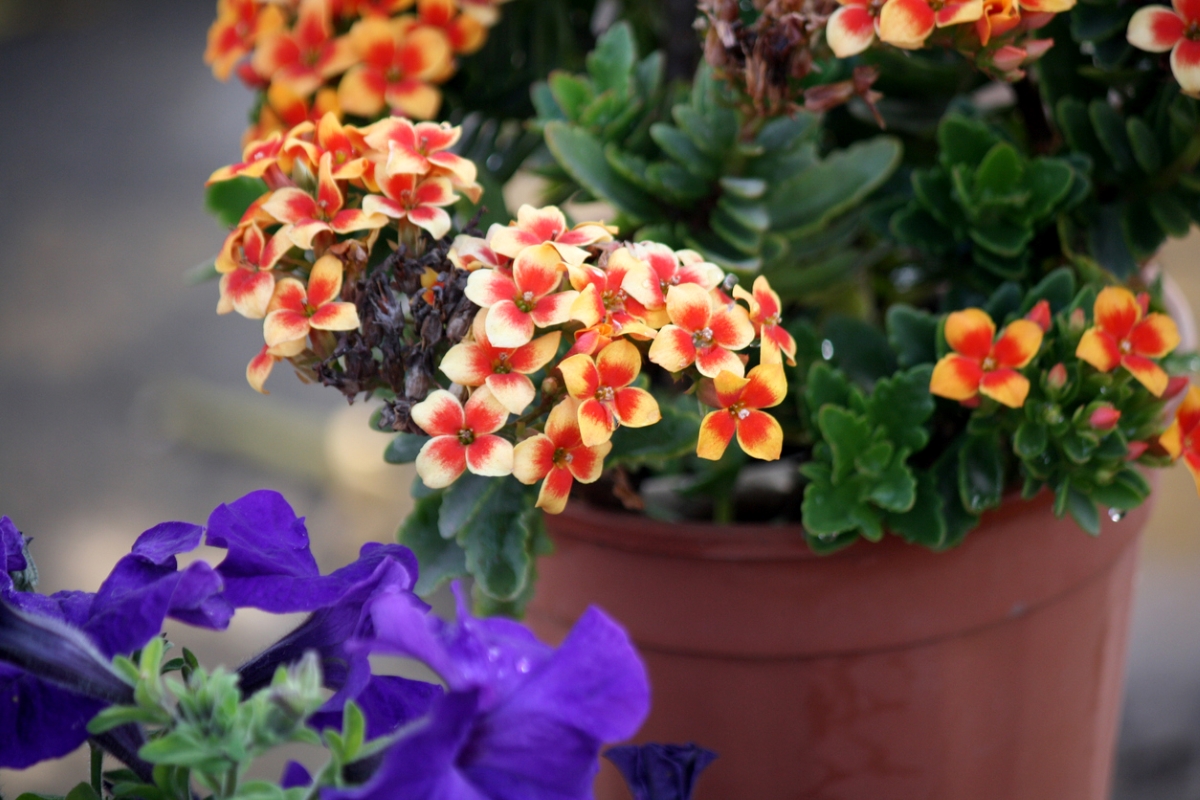

We may earn revenue from the products available on this page and participate in affiliate programs. Learn More ›
Winter is a long season of brown lawns, bare trees, and frost-covered shrubs, which is precisely why it’s the perfect time to add a pop of color indoors. While poinsettias are traditional (and lovely), why not think outside the box when it comes to wintertime houseplants and select one that blooms during the darkest days of the year?
1. Amaryllis (Amaryllis)
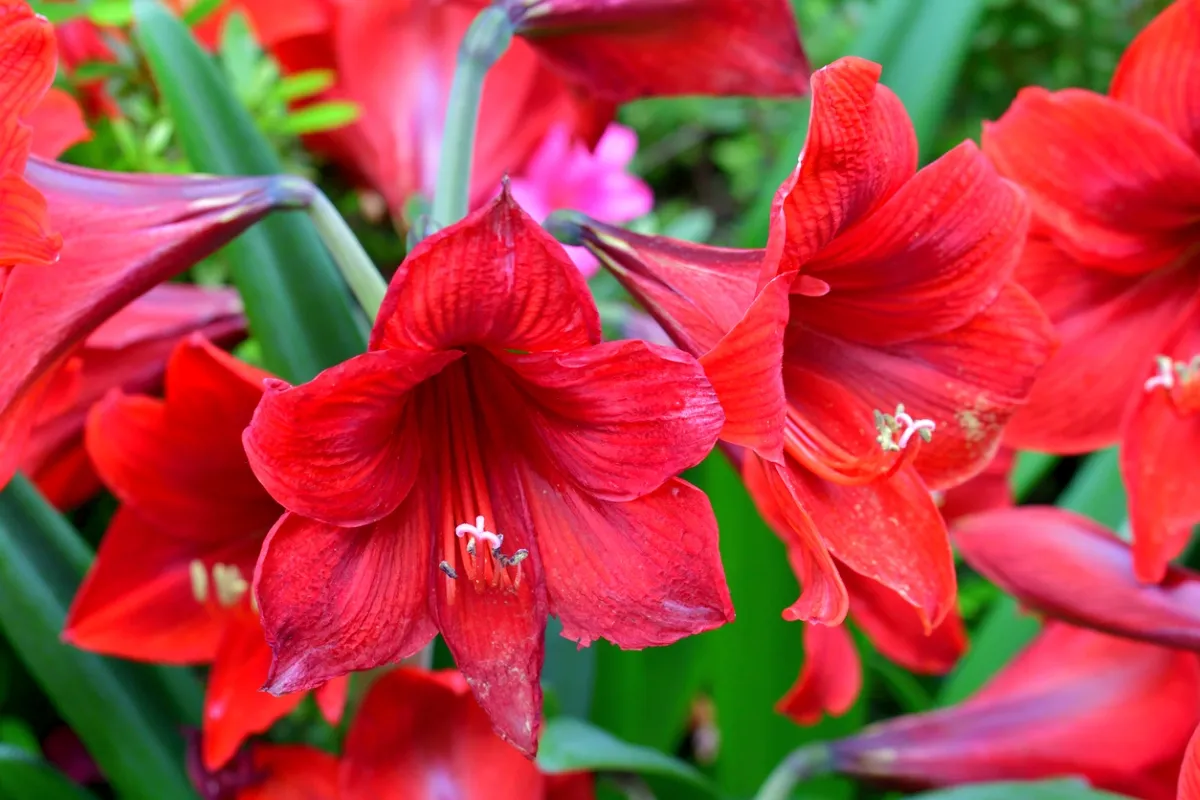
Amaryllis bulbs produce spectacular trumpet-shaped flowers. Timing is everything with this plant: Bulbs should be planted approximately 6 weeks before you want flowers. Once the flowering stops, snip the stalk a few inches above the bulb.
To encourage rebloom, remove the bulb from the soil in September and keep it in a cool, dark environment for 2 months before repotting. Think carefully about where you’ll place amaryllis: It can cause severe gastrointestinal distress to pets and people.
2. Paperwhite (Narcissus papyraceus)
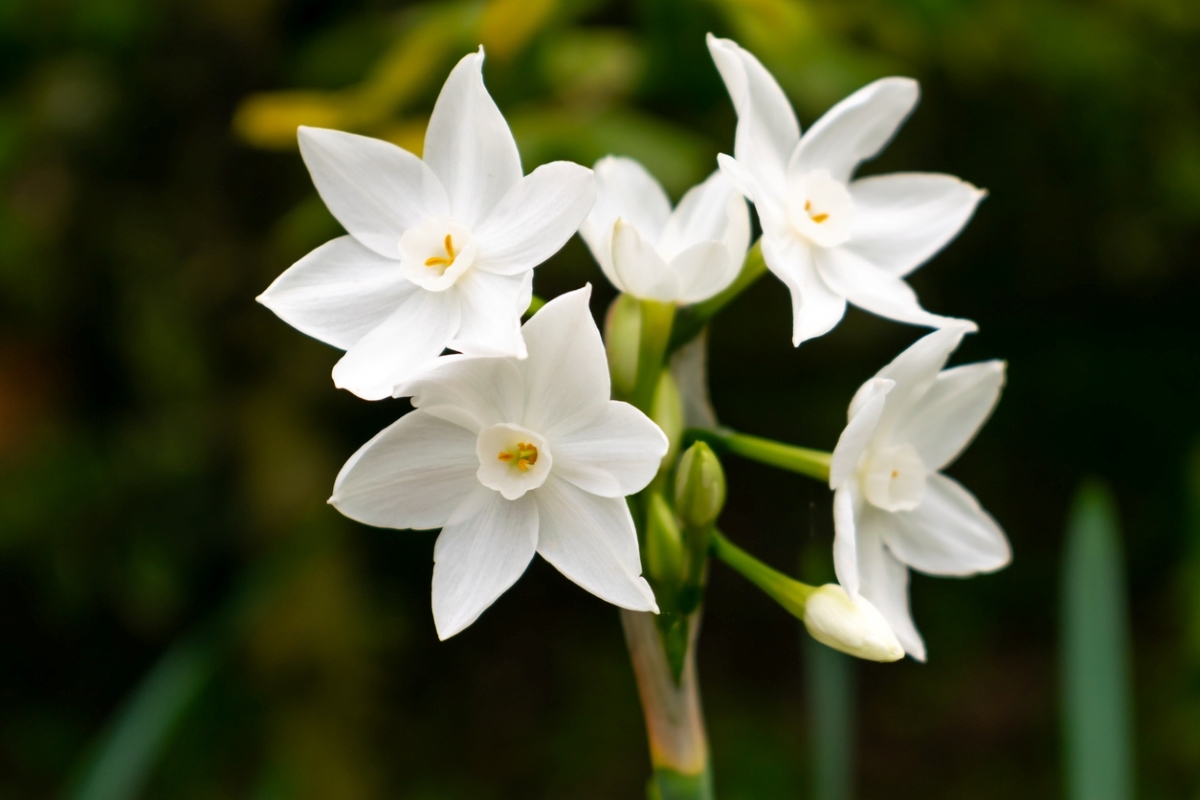
Despite their odorous reputation, paperwhites are a perfect pick-me-up plant, provided you steer clear of ‘Ziva’, a common (and smelly) variety that can quickly stink up an entire room. Opt for other paperwhites like ‘Cheerfulness’ and ‘Erlicheer’, which have a less-offensive aroma. Paperwhites don’t require prechilling and are easy to spot in late fall at big-box stores or online from specialty bulb companies. This plant, too, should be kept away from pets and kids, since it is toxic.
RELATED: 10 Plants You Can Grow Without Soil
3. Cyclamen (Cyclamen persicum)
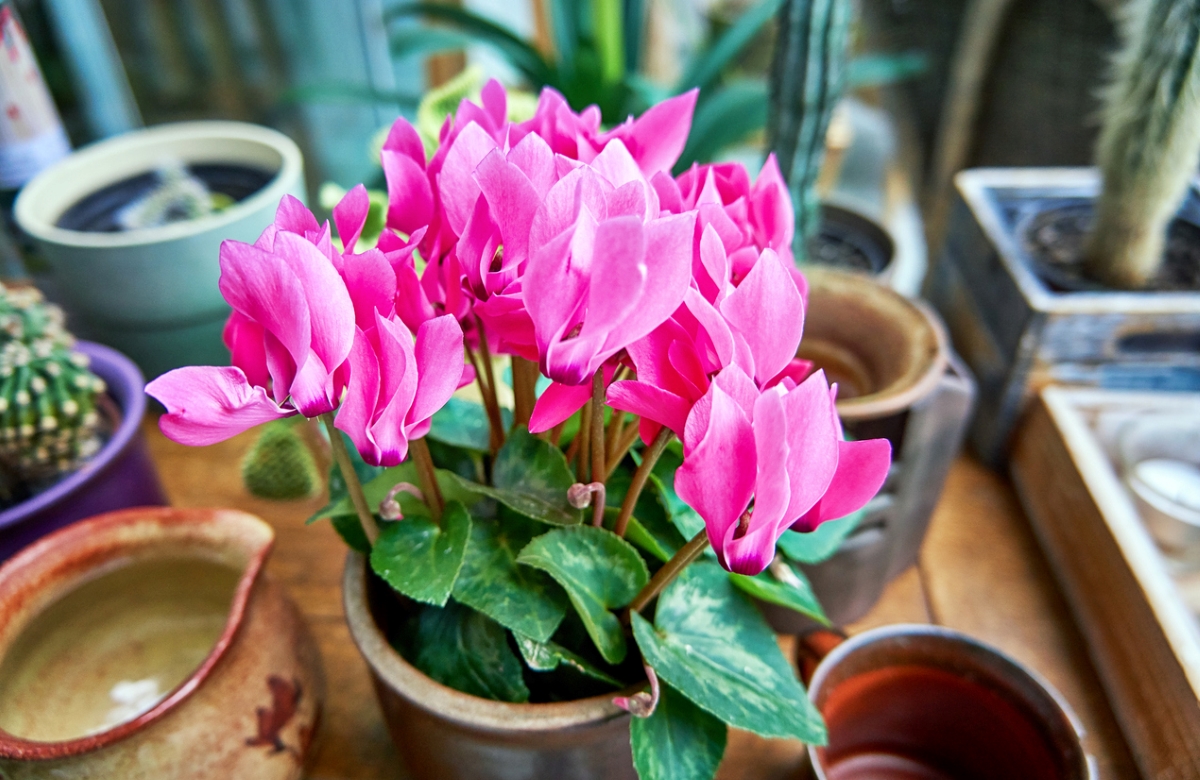
From December to April, cyclamen, which can bloom for weeks, sends up lightly fragrant flowers above heart-shaped, silver-marbled foliage. After flowering, the plant loses its leaves and dies back for the summer. Some owners might be tempted to toss spent cyclamens into the trash, but take note: The plant is not dead, just dormant. Continue to water it once in a while and when temperatures cool, it will start growing again. Cyclamen is toxic and should be kept away from cats, dogs, and kids.
RELATED: These Are the Most Popular Houseplants in America
4. Christmas Cactus (Schlumbergera)
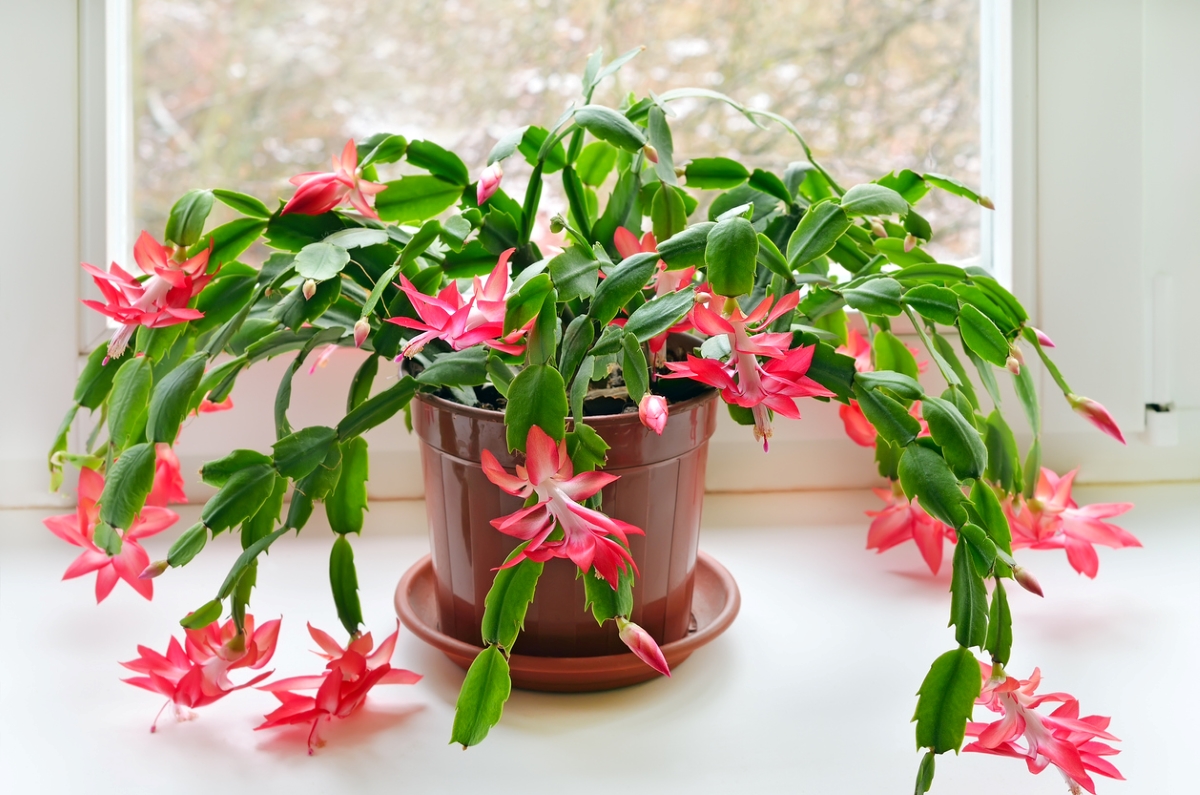
These striking succulent houseplants have been popular holiday gifts since the 1800s. Although named for its cactus-like foliage, Christmas cactus needs a little more water than its name suggests. Getting this nontoxic plant to rebloom takes a bit of coaxing in the form of light and temperature control, but it’s so worth it.
In mid-October, start giving the plant long nights of total darkness, 13 hours or more, in temperatures between 55 and 65 degrees, to trigger flower bud production. When buds appear, put the plant back in a sunny indoor location.
5. Rosemary (Salvia rosmarinus)
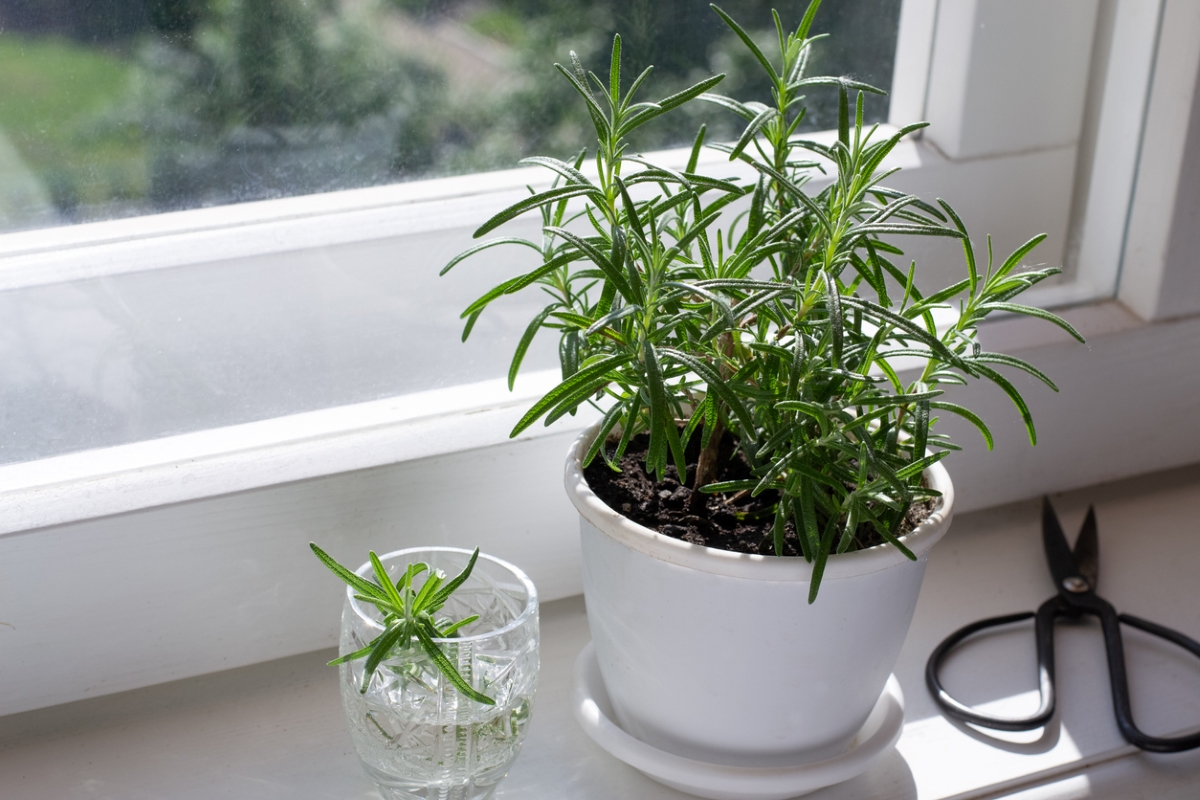
Rosemary probably won’t bloom, but the scent alone is enough to bring cheer. The plant is available during the holidays and can often be found in playful topiary shapes, including that of a Christmas tree. Place it in a sunny kitchen window where it can do double duty as decoration and culinary herb.
While rosemary isn’t harmful to pets or people in normal quantities, if your cat takes an outsize liking to the plant, move it out of reach, as it can be irritating in large quantities.
RELATED: How To: Propagate Rosemary
6. Desert Rose (Adenium obesum)
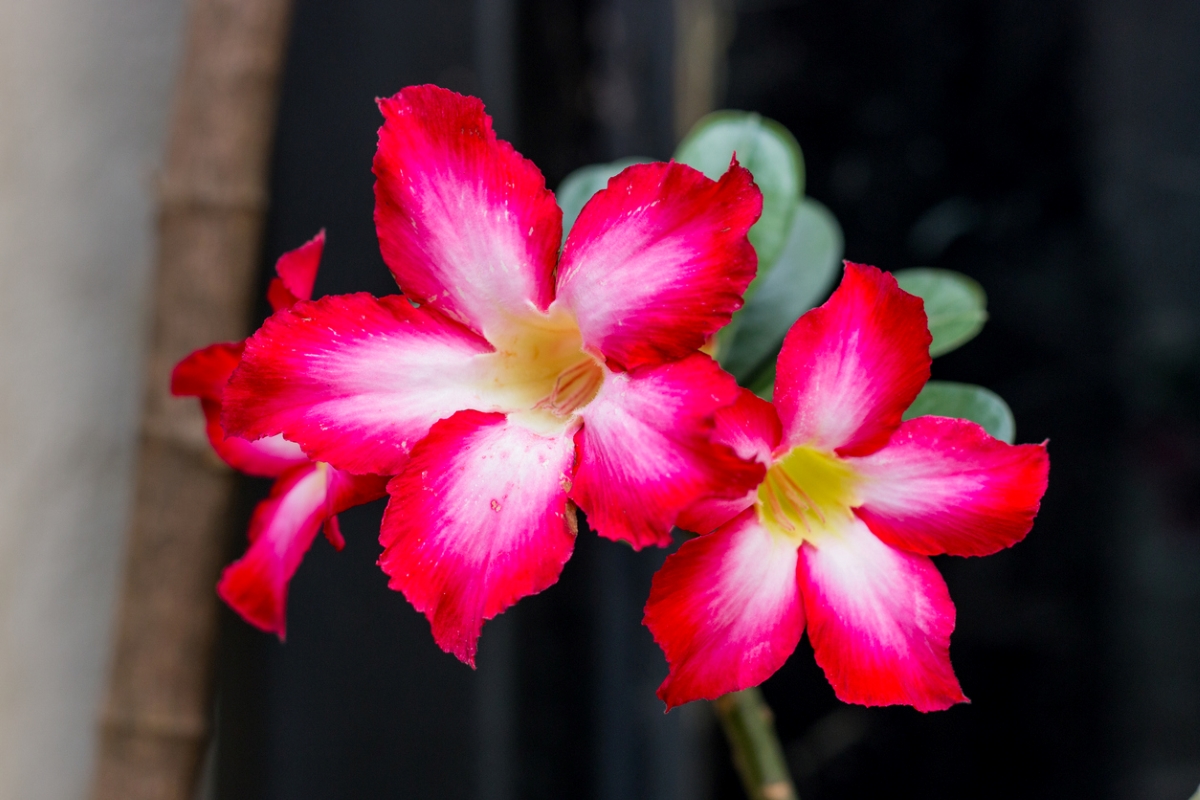
One of the most interesting succulents around, desert rose grows in a mini tree shape and produces stunning flowers. As you would do for other succulents, water desert rose sparingly. Thick stems give rise to flowers in solid colors—some varieties even have striping—that bloom throughout the year.
After flowering, it’s common for the plant to shed its leaves until new growth emerges in the summer, so don’t give up on it. This is another one to keep away from pets and kids as it is poisonous, particularly to cats.
7. Moth Orchid (Phalaenopsis)
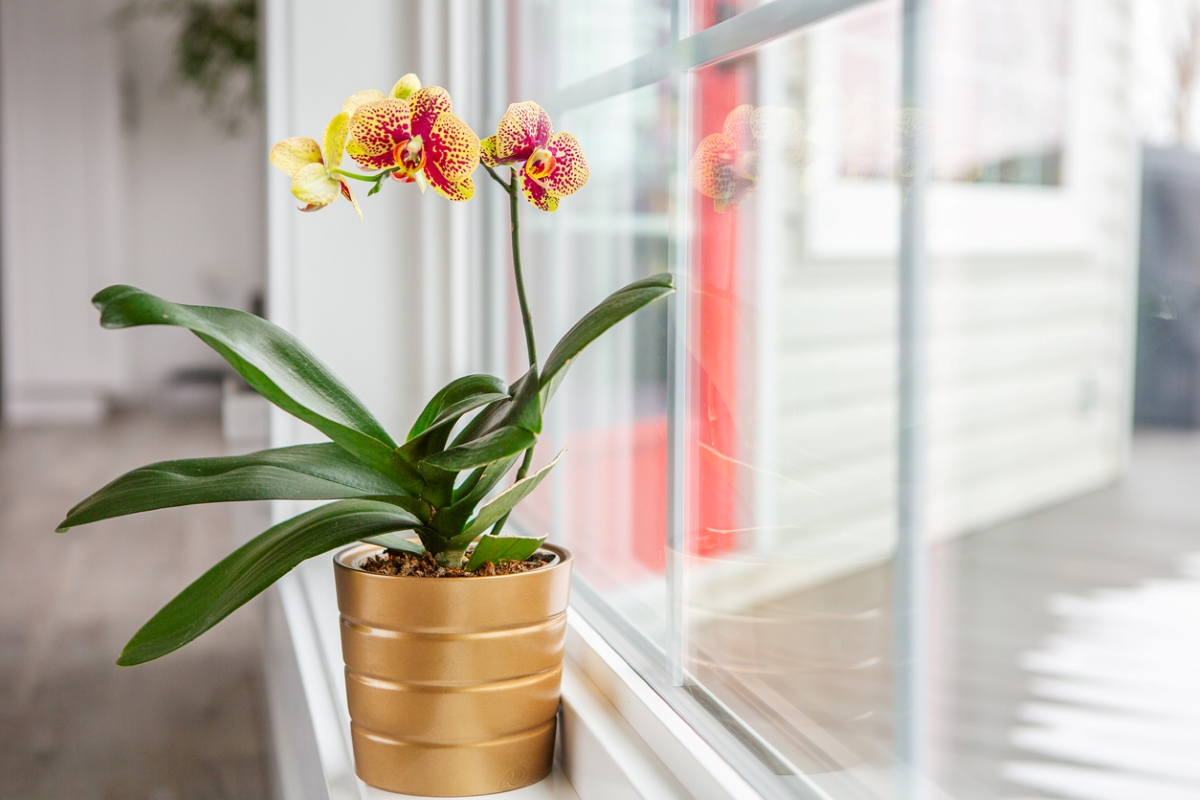
They get a bad rap for being fussy, but orchids are actually pretty simple, provided you offer them bright but indirect light and ample humidity. Water orchids thoroughly and allow them to dry out between waterings. Blooms last for months, so it’s best to choose a plant with buds that haven’t yet opened to get as much longevity out of them as possible. These beauties are nontoxic and safe for households with pets and kids.
RELATED: This Orchid Care Routine Will Keep Beautiful Blooms Coming
8. African Violet (Saintpaulia ionantha)
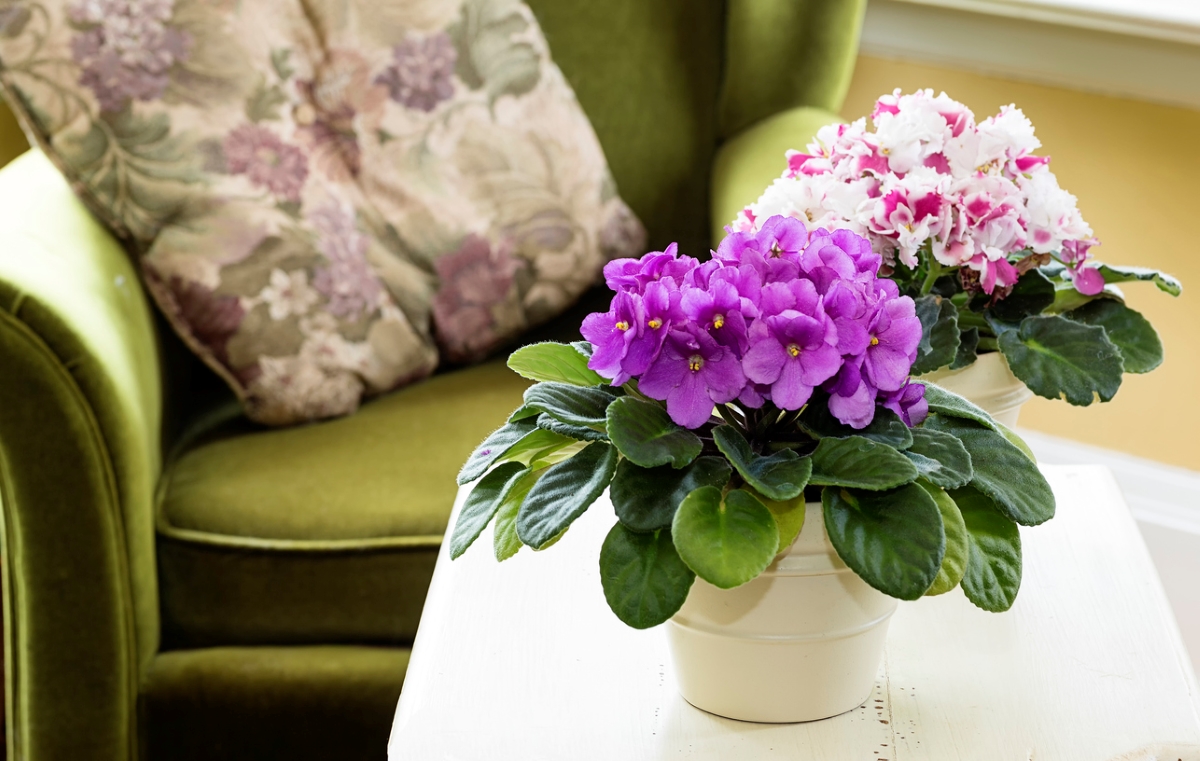
Situate the diminutive, nontoxic African violet plant in bright, indirect light and enjoy months of continuous flowering in shades of red, white, purple, and everything in between. Set yourself up for gardening success by picking up a specialized African violet pot with a slow-release wicking reservoir in the bottom that prevents damage to the leaves from overhead watering.
9. Begonias (Begonia)
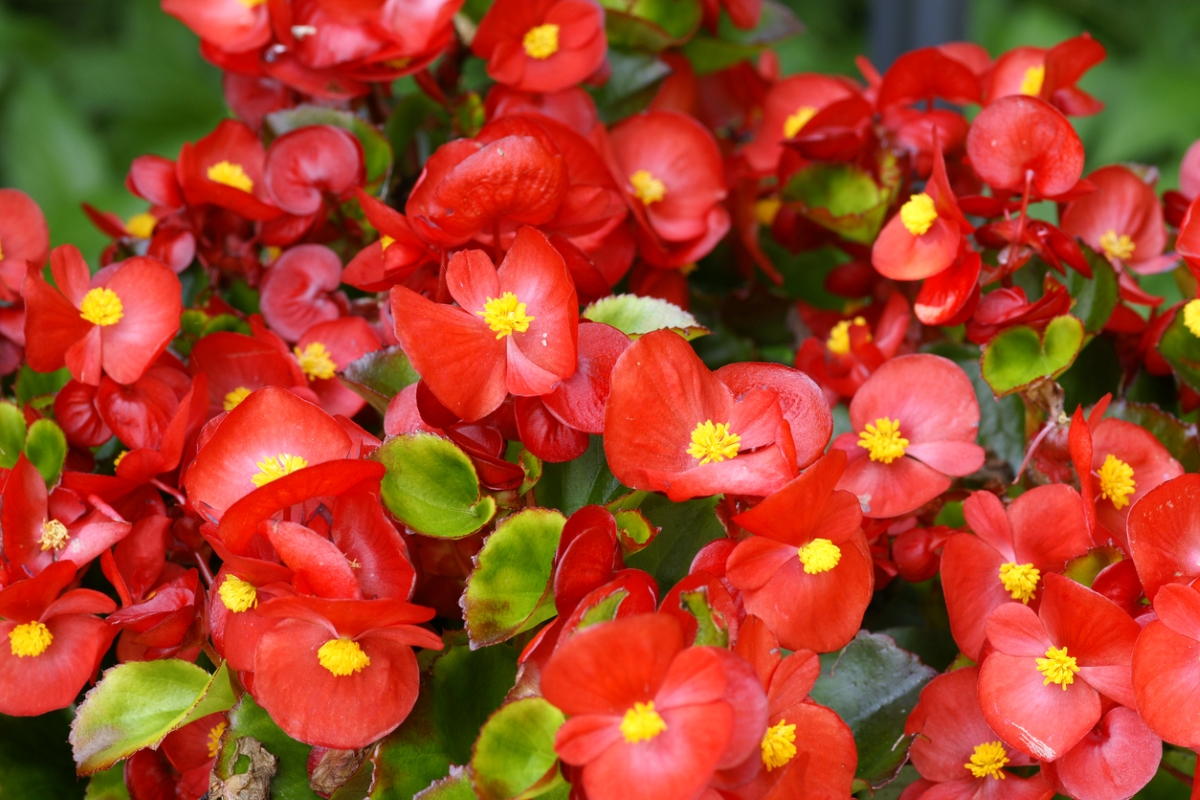
Give them bright, indirect light and plenty of humidity and you’ll enjoy a flower frenzy all winter long from indoor begonias. Dry air may be the norm at this time of year, but it’s a death knell for begonias, so set your plant on a shallow tray of water filled with pebbles to humidify the air around it. As much as they like water, too much of a good thing can be harmful. It’s best to water when the plant shows signs of thirst, such as drooping leaves. While begonias are not toxic to humans, they are toxic to pets.
RELATED: The Best Fertilizers for Indoor Plants, Tested and Reviewed
10. Peace Lily (Spathiphyllum)
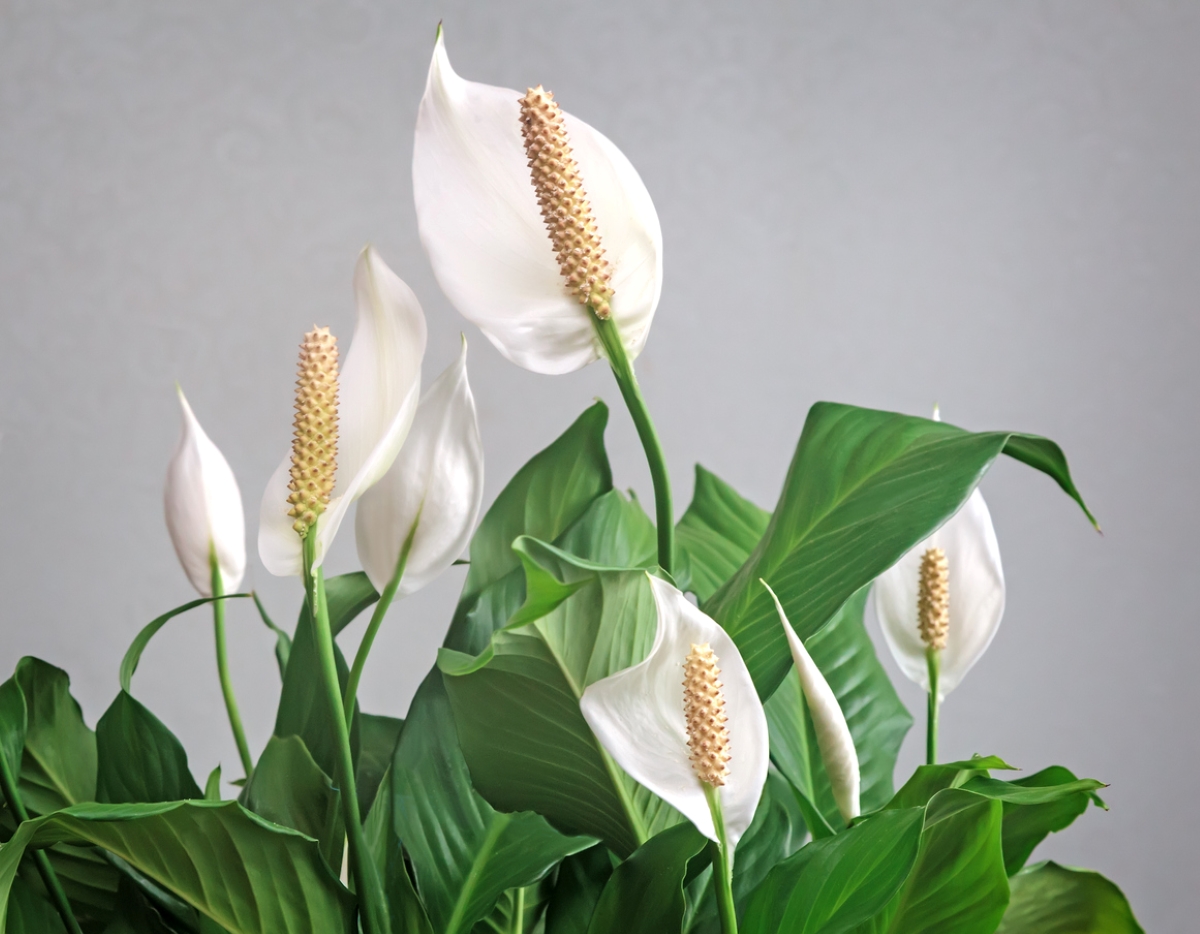
Add some green height (up to 6 feet) in a corner of the winter room with a peace lily. Several white flag-like flowers, which are really spathes, grace this beautiful but unpredictable plant. It can be hard to determine when and if a peace lily will flower, but it tends to send up stems in February, provided it receives sufficient bright, indirect light. Keep this toxic plant away from pets and kids.
RELATED: This Peace Lily Care Routine Is so Low Maintenance, You Don’t Need a Green Thumb
11. Flowering Maple (Abutilon spp.)
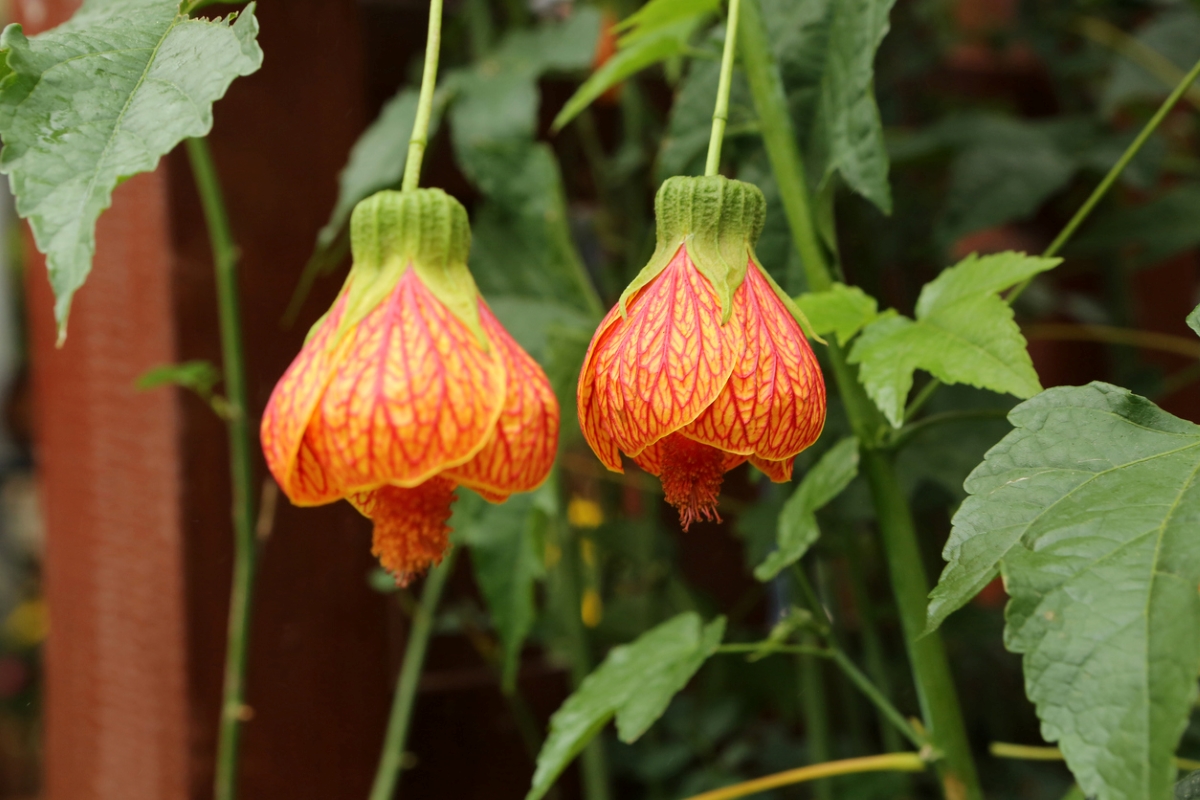
One of the more unusual and upright houseplants, flowering maple blooms almost nonstop. Palmate maple-like leaves and pendulous flowers resembling Chinese lanterns make for an interesting display. The variegated leaves of certain varieties up the interest, but variegated and non-variegated leaves can be irritating to skin so you might want to wear gloves while working with this plant. The plant is nontoxic to pets.
12. Kaffir Lily (Clivia miniata)
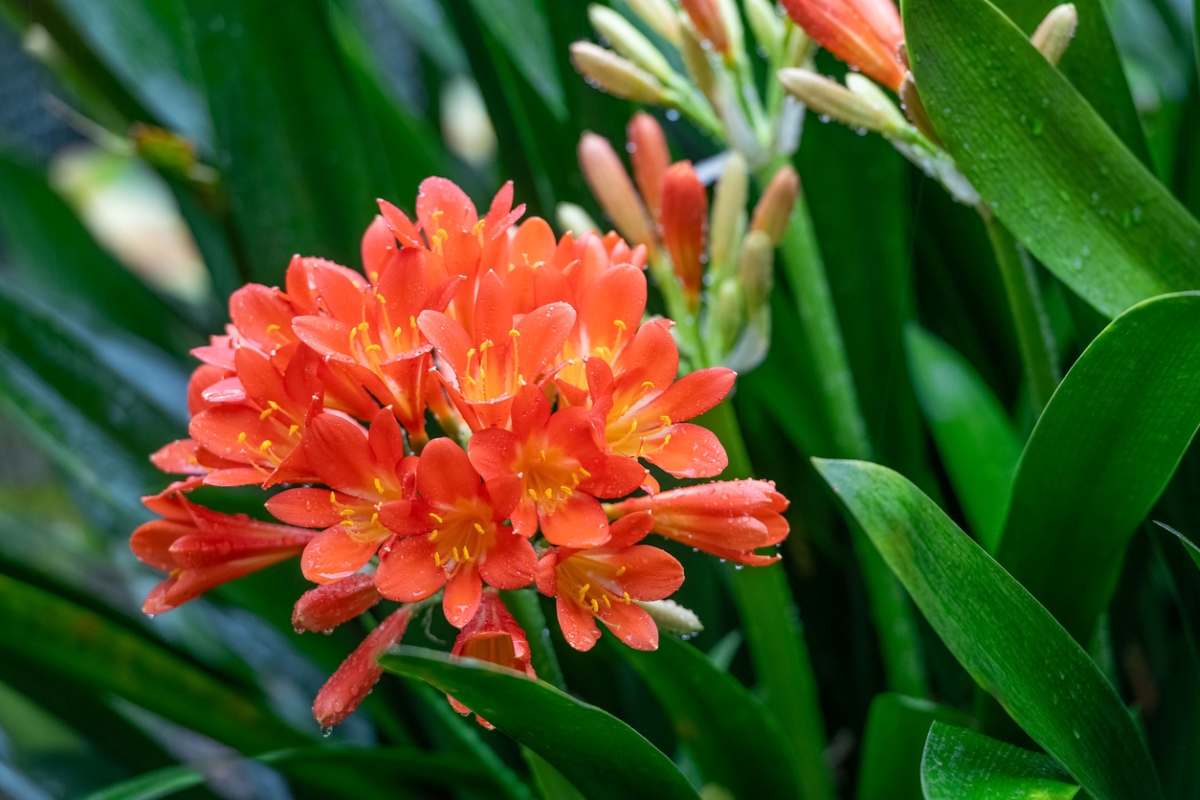
Like amaryllis and Christmas cactus, clivias need a chilling period to trigger the development of clusters of orange or yellow lily-like flowers. With no need for high humidity, clivia is perfectly suited to indoor life and will thrive in a bright north-facing window. Kaffir lily contains small amounts of the alkaloid lycorine, which is toxic to humans and pets if consumed in large quantities.
RELATED: How to Help Your Houseplants Survive the Winter
13. Jasmine (Jasminum)
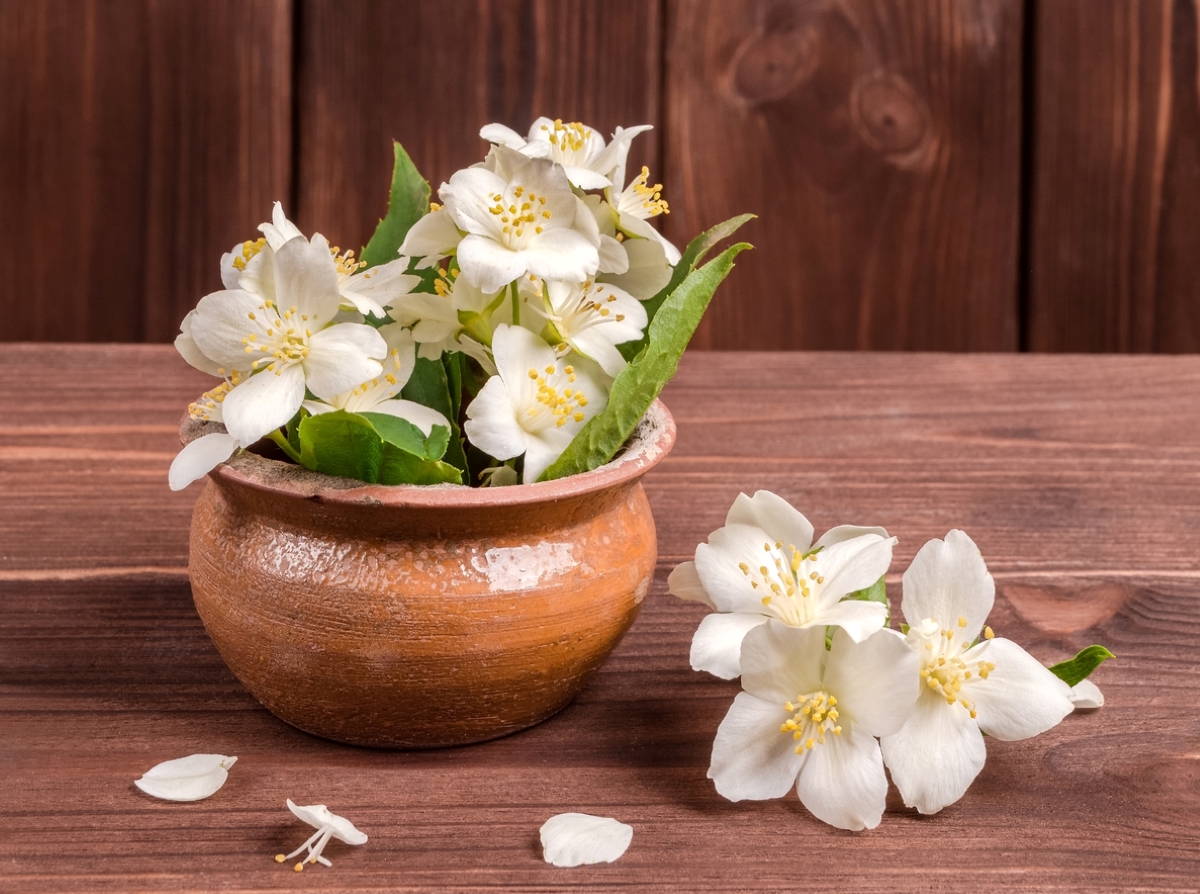
Typically a summer bloomer, jasmine can be found blooming in stores and homes during the winter, adding sweet fragrance to indoor spaces. To encourage rebloom the following year, give it a time-out in the fall in a room that is completely dark at night. Exposure to street light or indoor lighting will interrupt the cycle. Give this nontoxic plant a trim once it blooms, since jasmine tends to get leggy.
14. Bleeding Heart Vine (Clerodendrum thomsoniae)
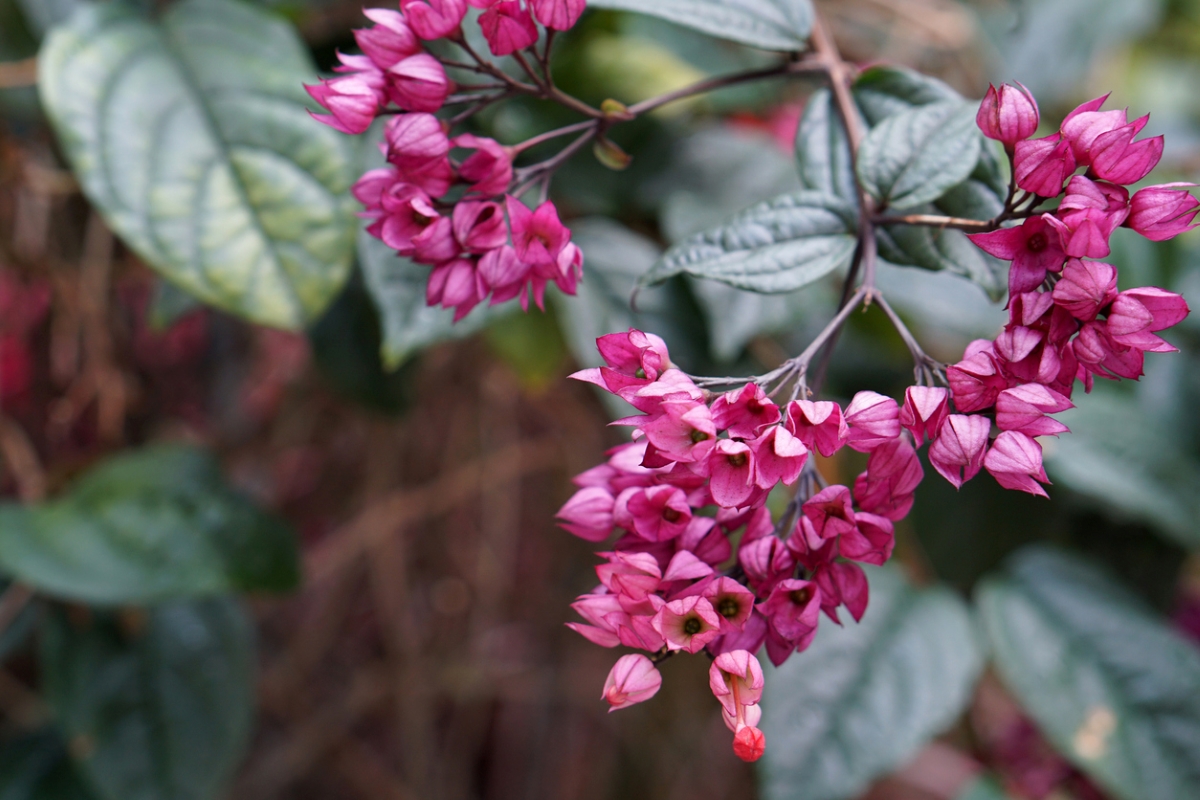
Not to be confused with bleeding heart plant (Dicentra spectabilis), bleeding heart vine is a beautiful climbing plant that produces long-lasting clusters of pink or partly red flowers when placed in a sunny window. Give it a trellis or support to climb, and prune back hard after flowering to keep it under control. Don’t worry about pets and kids getting close; this one’s nontoxic.
15. Kalanchoe (Kalanchoe)
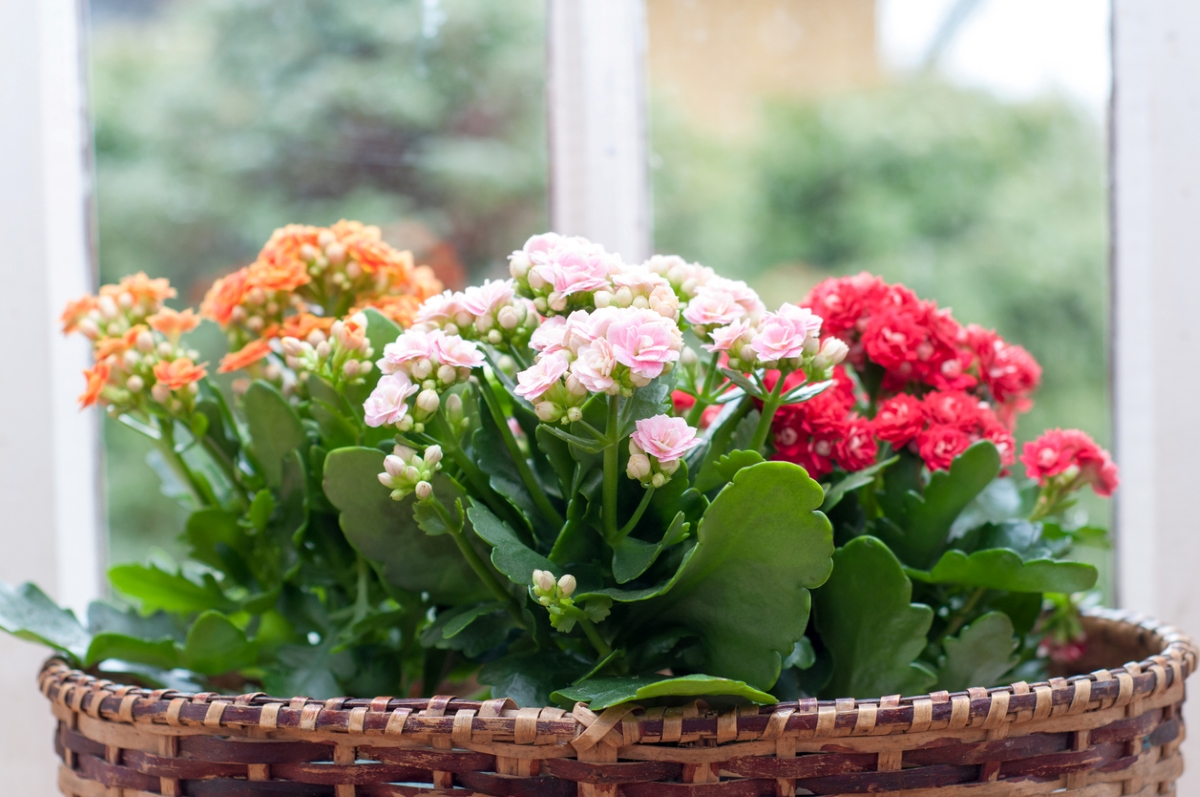
One of the easiest houseplants to grow and find, kalanchoe tosses out clusters of flowers in deeply saturated hues. The trick is preventing the tropical succulent from becoming too leggy. Pinch it back after flowering and a rebloom should be close behind. Keep this one away from pets and kids, as it is toxic.
RELATED: Master Easy Kalanchoe Plant Care for a Blaze of Colorful Blooms Year After Year
16. Cineraria (Pericallis x hybrida)
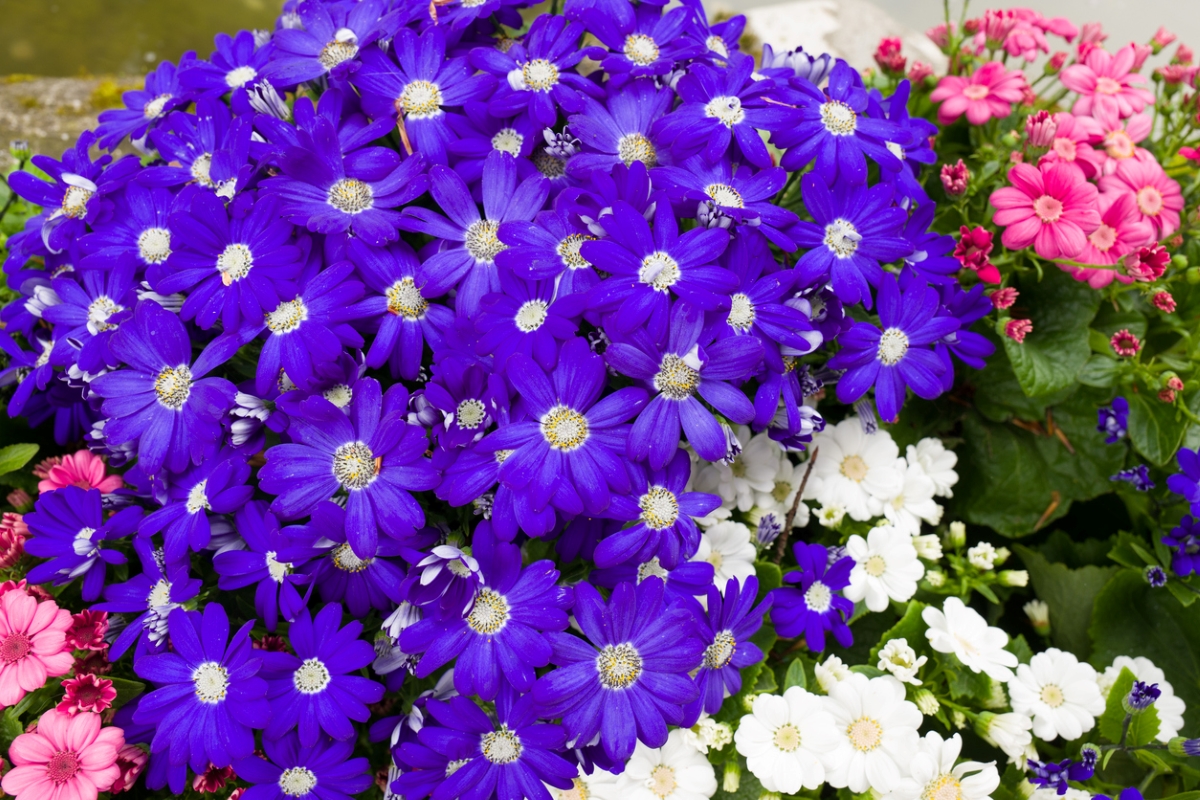
Enjoy large daisy-like flowers indoors with cineraria. Compact clusters of daisy-like flowers sit atop large dark green leaves. Flowers can be red, purple, blue, or white, and each flower has a center eye surrounded by a small white ring. Purchase plants with plenty of buds to get the most out of the bloom period, and keep this poisonous plant away from pets and children.
17. Anthurium (Anthurium)
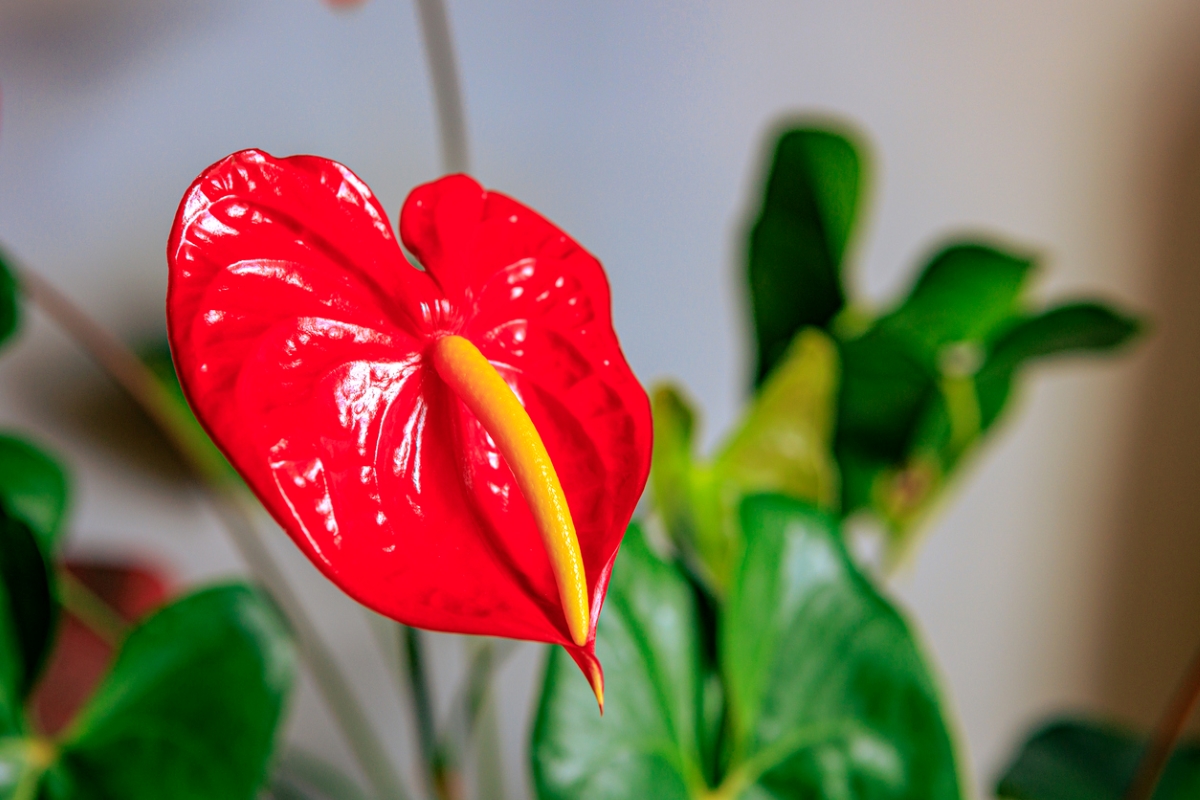
What many consider a flower is really a spathe that emerges from the plant in hues of red, pink, white, and variegated colors. Each spathe displays a contrasting white or yellow flower spike within. Anthurium prefers bright light and high humidity, which may be challenging in a heated home. Place the plant on a shallow pebble-and-water-filled tray, away from kids and pets, to increase the humidity.
RELATED: How to Increase Humidity for Your Houseplants, Even During the Driest Days of Winter
18. Azalea (Rhododendron spp.)
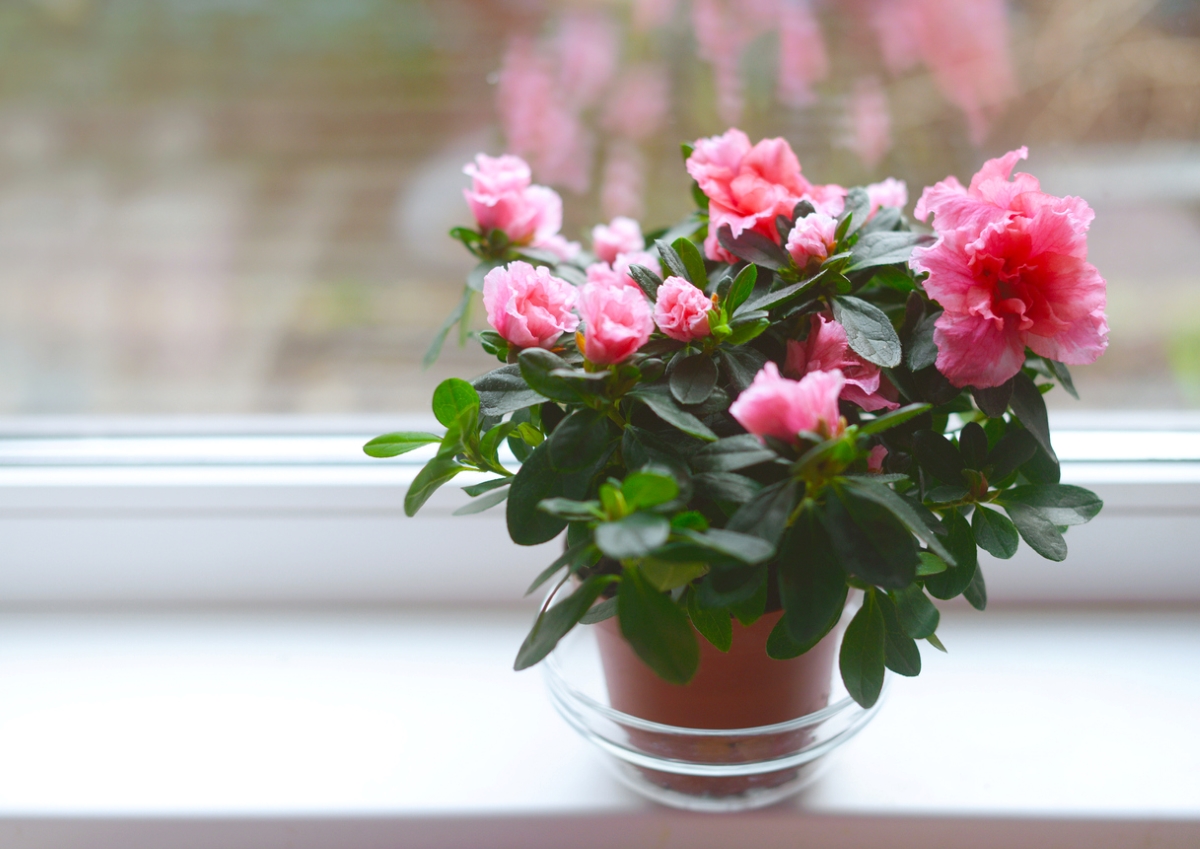
Not to be confused with hardy azaleas, greenhouse azaleas are meant to be grown indoors and will not survive if planted in the garden. Select plants with plenty of unopened buds to increase the amount of time you can enjoy its blooms, and be sure not to let the soil dry out. Swallowing large quantities of this plant can spell trouble for pets and humans, so if your dog is a habitual plant snacker, keep azaleas safely away.
RELATED: 20 Flowering Houseplants That Will Add Beauty to Your Home
19. Gloxinia (Sinningia speciosa)
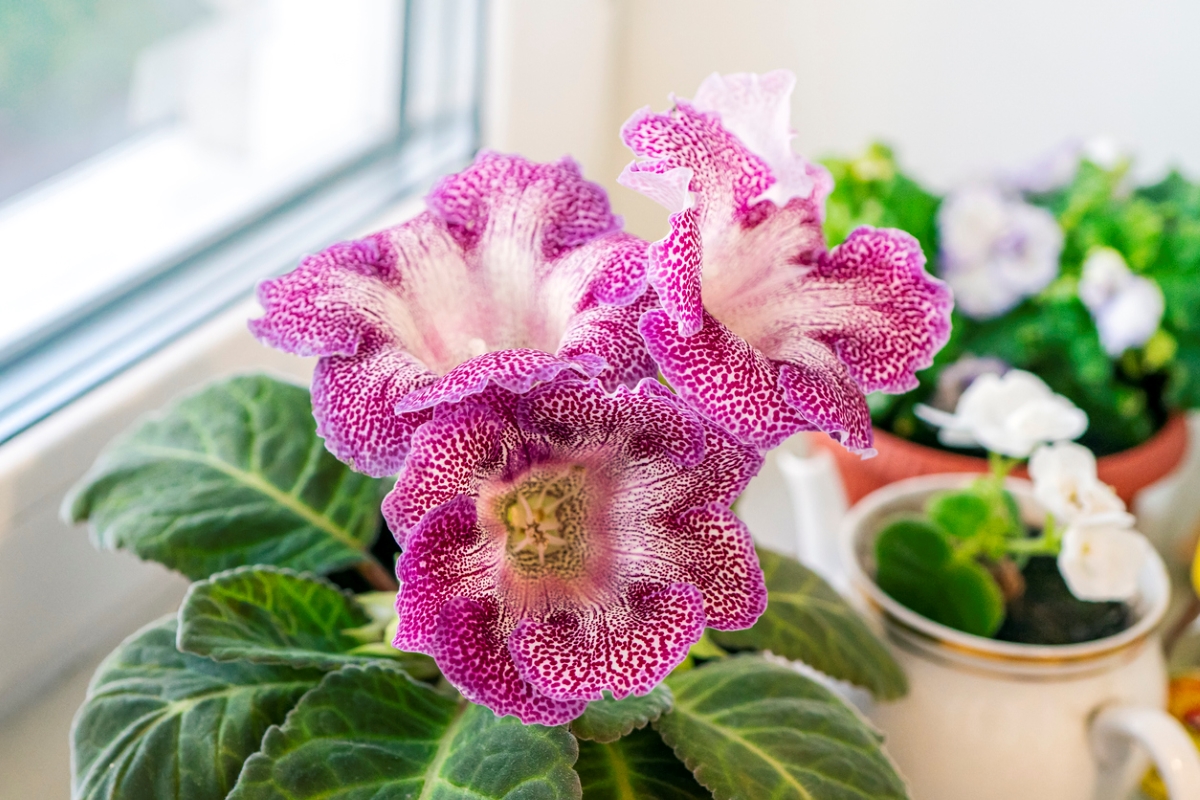
Traditionally grown as a perennial, today’s gloxinias are bred to produce masses of blooms without regard for the long-term health of the plant. By the time they’ve finished flowering, the plant simply has nothing left. For this reason, it’s just as well to think of this nontoxic plant as an annual and treat it well while it’s in bloom: keep it in bright, indirect light, water it enough to keep the soil moist, and feed it with a high-phosphorus liquid plant food every 2 weeks.
20. Goldfish Plant (Columnea nematanthus)
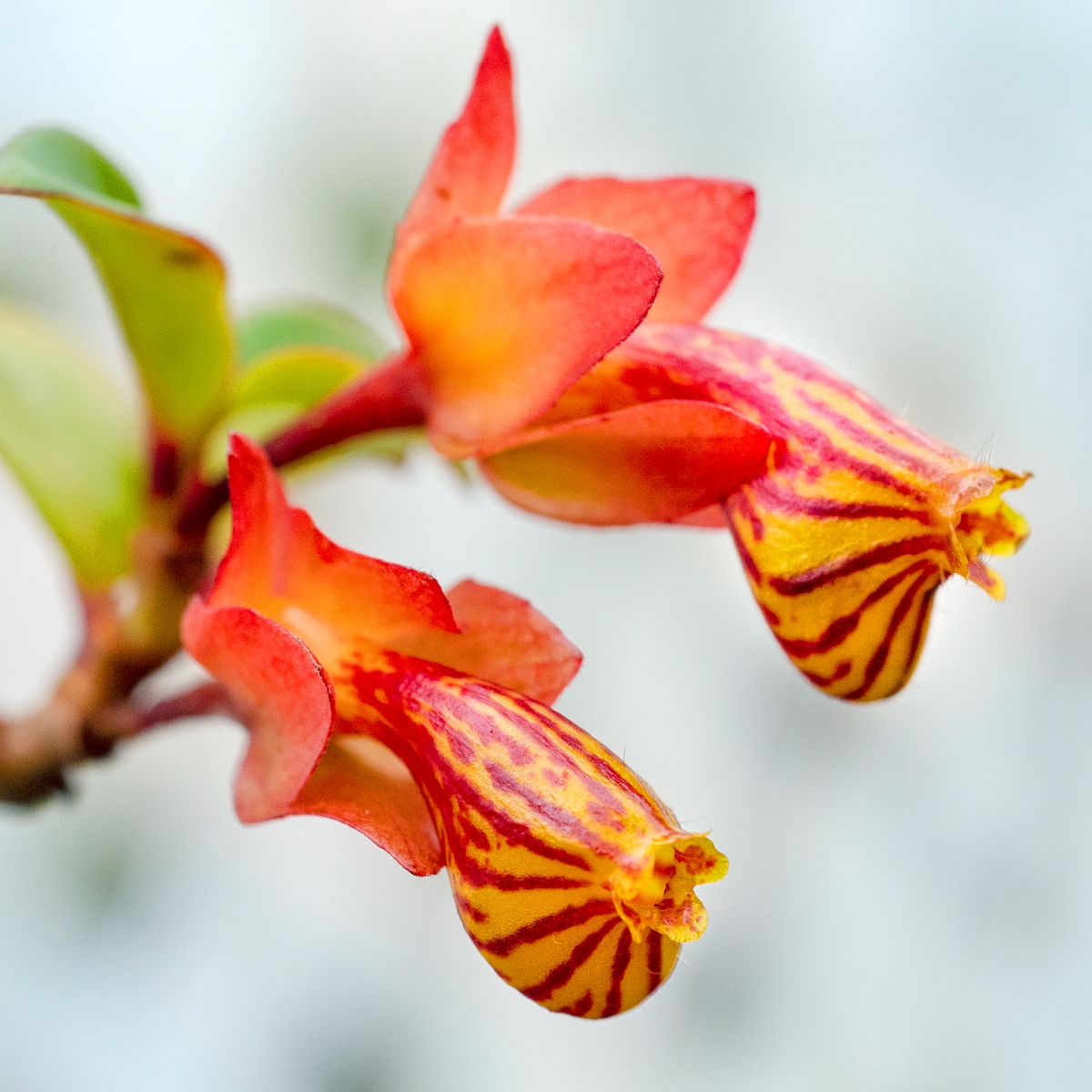
As the name implies, the flowers on this columnea resemble small goldfish in shades of red, orange, or yellow. Trailing dark green foliage makes the goldfish plant an excellent choice for a hanging planter in bright light. As with African violets, avoid getting water on its leaves, which will cause browning and, in some cases, fungal problems. If your cats are tempted by the goldfish plant, as they might be by actual goldfish, worry not: This plant is harmless to pets.
RELATED: 13 Plants You Can Winter Indoors
21. Lipstick Plant (Aeschynanthus radicans)
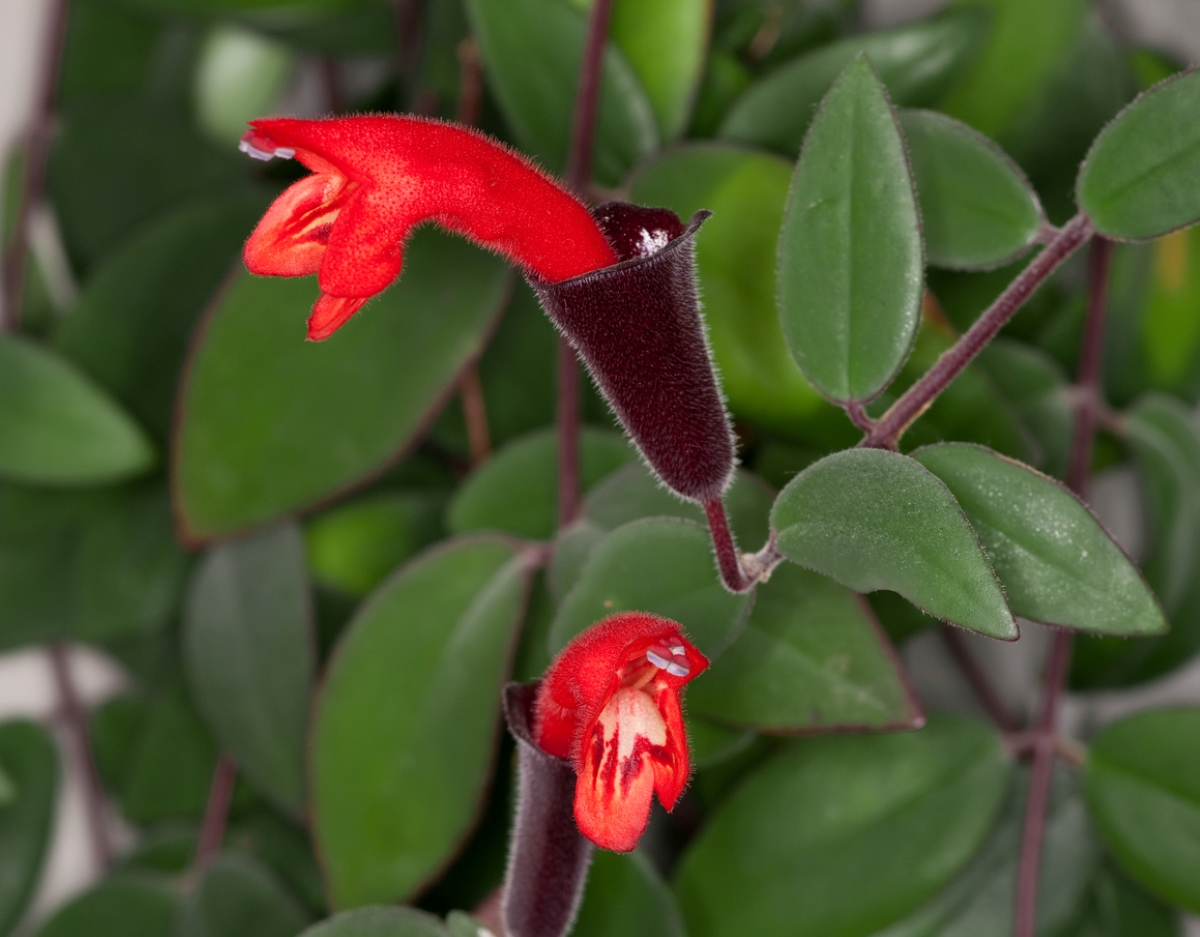
Add a taste of the tropics to your indoor winterscape with lipstick plant, a vining beauty that looks fantastic in a hanging basket or cascading down a tall piece of furniture. The red, tubular flowers of this nontoxic plant are an exciting and vibrant contrast to its glossy dark green foliage. The plant prefers bright, indirect sunlight and temperatures of 65 to 75 degrees Fahrenheit. It appreciates a bit of humidity, so keep a spray bottle handy, and also apply a slow-release fertilizer once a month.
22. Purple Shamrock (Oxalis triangularis)
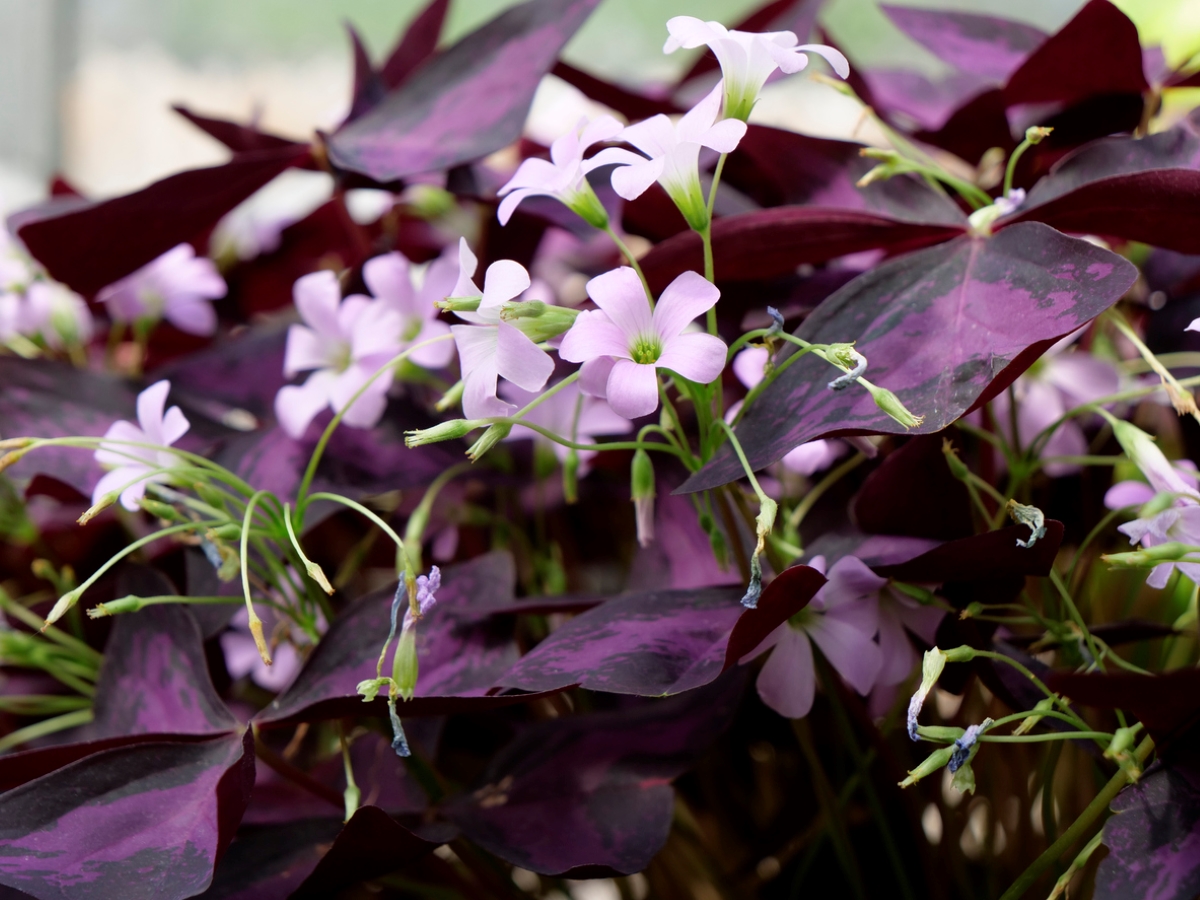
The leaves of this brightly hued plant resemble those of a shamrock, though they’re much larger and they’re purple! This South American native also produces delicate five-petaled flowers in white or pink that show off during the day but button up at night. Oxalis likes humidity and temperatures of 65 to 75 degrees Fahrenheit. Keep purple shamrock plants in bright direct light, but out of reach of pets and children, as it is toxic and can be quite irritating and even dangerous if ingested.
RELATED: How to Help Your Houseplants Survive the Winter
23. Crown of Thorns (Euphorbia milii)
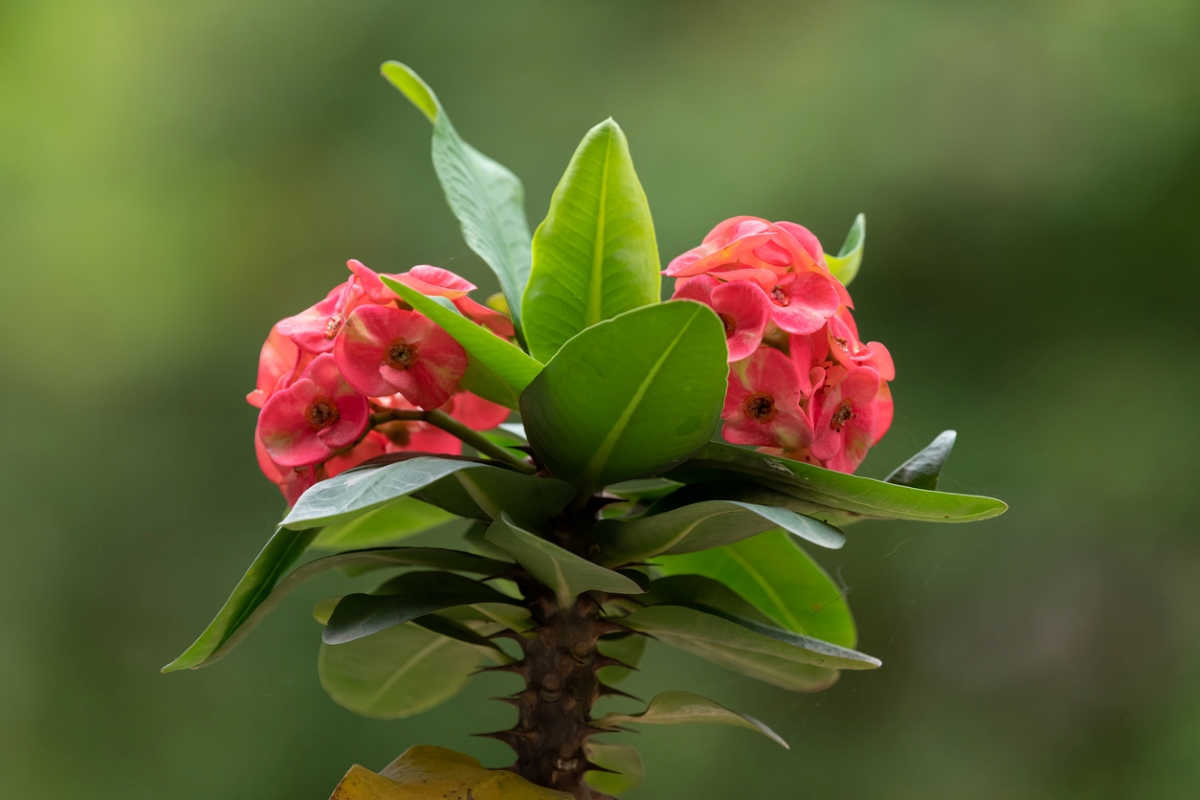
If you can get past this succulent’s thorniness and toxicity, crown of thorns makes an intriguing addition to a houseplant collection. Its thick, thorn-covered stems support clumps of 2- to 6-inch-long medium-green leaves topped by clusters of small pink, white, or yellow flowers that bloom year-round. Put it in a sunny spot and fertilize it monthly. Note that this is a good plant for those who are stingy with the watering can, since it doesn’t mind drying out. It’s not good, however, for households with pets or kids, as it’s prickly and poisonous.
